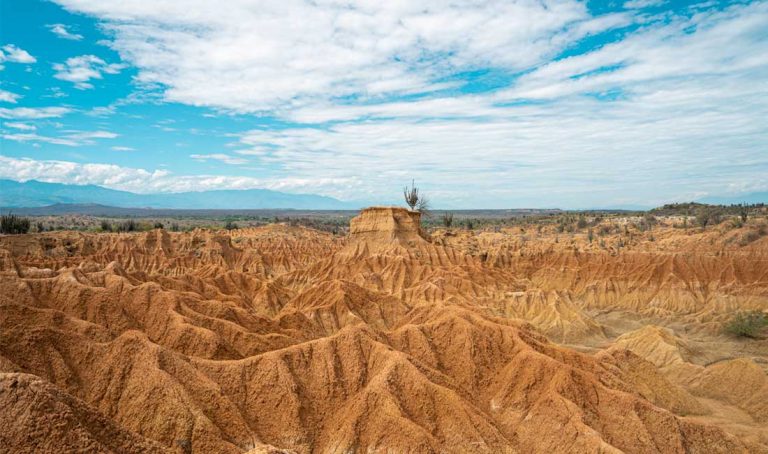Updated on 03/14/2024
Dear reader,
I would also like to recommend our Colombia travel guide, which provides a perfect overview of the tourist attractions in Colombia. Enjoy reading it!
Content
Introduction to Colombian Tourist Destinations
Colombia has numerous tourist destinations and is still an insider tip. The wealth of culture and biodiversity in this beautiful country is incomparable. Below I recommend 99 places in Colombia that I hope will inspire you.
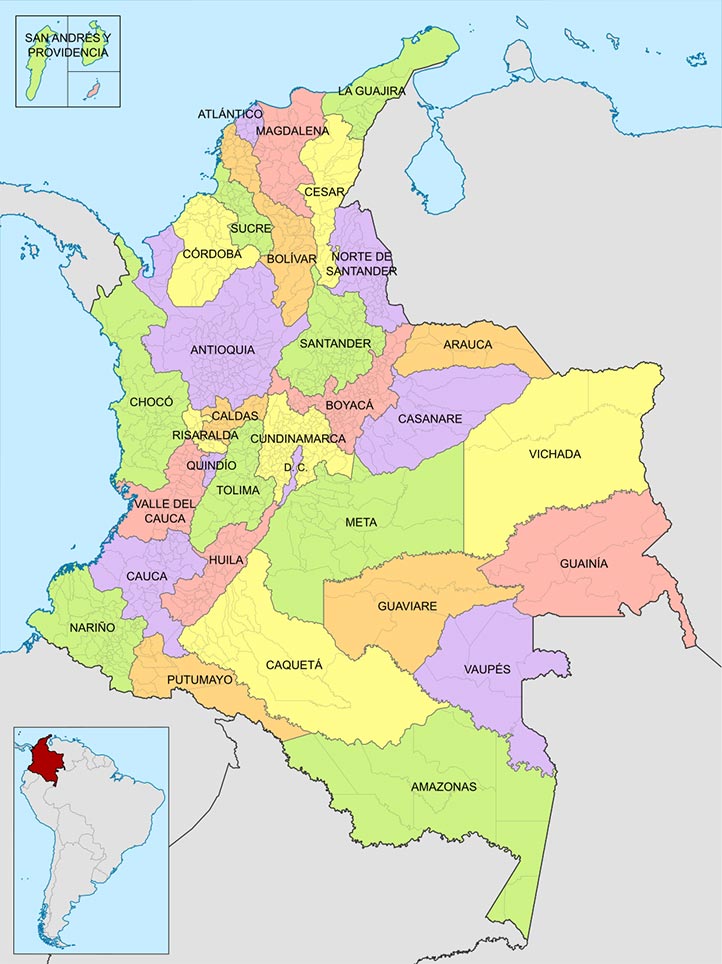
Explore the Wonders of the Andean Region of Colombia
The Andean region of Colombia is a land of diversity, beauty and history. It is home to the Colombian Andes, a mountain system that consists of three parallel ranges: the Cordillera Occidental, the Cordillera Central and the Cordillera Oriental. These ranges offer stunning scenery, rich biodiversity, ancient cultures and modern cities. Whether you want to hike in the snow-capped volcanoes, visit the colorful colonial towns, learn about the pre-Columbian civilizations or enjoy the vibrant nightlife, the Andean region of Colombia has something for everyone. In this article, we will introduce you to some of the most amazing destinations in this region and help you plan your next adventure.
 Bogota, Capital District
Bogota, Capital District
The capital of Colombia shows the history of colonization, as it was founded by the Spaniards in 1538, but was inhabited by indigenous tribes a long time before. Bogotá is the economic, political and tourist center of this beautiful country and has a lot to offer.
La Candelaria is the central point of the city, the historical center with various museums, hotels and attractions. To me Bogota is the most interesting city in Colombia with most top tourist attractions.
Museo del Oro
This museum hosts a great presentation of the history of Colombia, particularly Bogotá. The museum has over 55,000 valuable items, 30,000 of which date from the pre-Columbian and colonial times and are made of gold.
I recommend taking a guided tour of the museum. In this way you can learn more about the different epochs, the important people of the tribes or groups that formerly populated the area.
For those interested in culture and museums, we also have an overview of the most important museums in Colombia on our website.
Monserrate
Bogota’s local mountain is the capital’s main tourist destination. There are three ways to get to the top. On foot, by cable car or funicular. On foot, the physical effort is great when you consider the altitude of over 3,000 meters above sea level, so you should think twice.
Once at the top, a beautiful cathedral awaits you, which is best visited during the week. The rush of visitors is usually very large on Sundays. Behind the cathedral, a path leads past shops selling handicrafts and special Colombian souvenirs, then there are several restaurants where you can try typical Colombian dishes.
Teatro Colón
Dedicated to opera, this neoclassical theater was built in 1885, is the oldest in South America and is currently home to the Bogotá Symphony Orchestra. Because of its beauty and architectural style, the theater has also been crowned one of the 7 wonders of Colombia.
 Medellin, Antioquia
Medellin, Antioquia
The paisa culture is deeply rooted in this department and it is a tourist destination that offers activities and landscapes in cultural, historical and natural terms. Medellín, the capital of the department, offers a promising and unforgettable tourist stay. This innovative city is one of the most populous cities in Colombia, and best known for its tragic history of violence.
Jardín
Jardín is visited by a large number of tourists every year. It is one of the most beautiful and romantic towns in Antioquia and all of Colombia. It is also part of the exclusive club of the country’s 17 cultural heritage towns. You are sure to fall in love with the village’s colorful architecture and the nature that surrounds it.
Guatapé
This is another wonderful village in Antioquia which is also known as the most colorful town in Colombia. Guatapé is not only known for its fantastic architecture, but also for the El Peñol rock, which can be climbed in 650 steps. It can be exhausting, but it’s worth it. At the summit, you will be rewarded with a magnificent view of the Guatapé reservoir and its surroundings.
Támesis
This spectacular town, thanks to its natural wealth, offers a wide variety of activities such as hiking, mountain climbing, bird watching and much more. Támesis has a good atmosphere with happy residents and ecological trails that allow you to immerse yourself in Colombian biodiversity.
 Tunja, Boyacá
Tunja, Boyacá
Boyaca is considered the number 1 destination for religious tourism and offers not only several historical cathedrals, but also a variety of nature and cultural wealth. The capital Tunja has an architecture steeped in history and offers a diverse tourist infrastructure. For more information, check out my guide to Boyaca here.
Cañón de Chicamocha
The Chicamocha Canyon is over 220 kilometers long and extends into the department of Santander. I can only recommend a visit, because its greatest depth is 2 kilometers. There is a park, called PANACHI, where you can have a fun day with marvelous views.
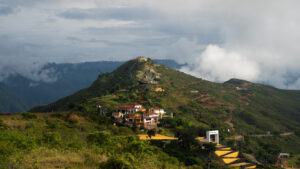
Villa de Leyva
This historic city is known in Colombia for its architecture, for having the largest central square and cobblestone streets. In Villa de Leyva you can learn about the colonial history of Colombia and fall in love with its landscapes and the adventure, culture and nature activities. You can find my travel guide about Villa de Leyva here.
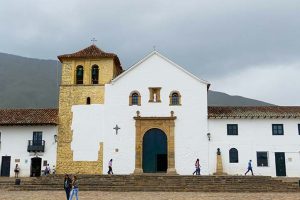
Playa Blanca
In Boyacá there is a large lagoon called Tota, with a beach with a Caribbean atmosphere and very clear sand. The water is very cold and shines in green and blue. This is undoubtedly one of the most famous tourist attractions in the Boyacá department.
 Manizales, Caldas
Manizales, Caldas
This department offers the most beautiful coffee landscapes, thermal soils and mountain regions. Thanks to its geographical location, you can find snow-capped mountains, forests, hills and valleys. The capital Manizales is known today as the “City of Open Doors”. It is known for the friendliness of its residents and the beauty of the surrounding landscapes.
Nevado del Ruiz
The volcano is known in Colombia for its impressive views. The hike can be long but well worth it. The temperature on the summit regularly drops below 0º.
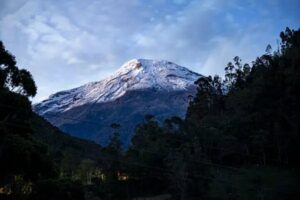
Ciudad de Manizales
The capital Manizales has a lot to offer for tourists. I recommend visiting the city in January during the Feria de Manizales. This is the most important local festival and you get a glimpse of the local culture and even see jeeps dancing.
Salamina
Salamina has been named a National Monument of Colombia and is a special place. The architecture reflects the history of the Spanish colonists. Salamina is still an absolute insider tip.
 Cundinamarca
Cundinamarca
In the third most populous department of Colombia is Bogotá, the capital of the country. Cundinamarca is one of the most important departments in Colombia. It is not only geographically central, but also one of the economically strongest departments of Colombia.
Laguna de Guatavita
La leyenda del dorado. “The Legend of El Dorado”. In the lagoon with its beautiful emerald green water, the myth played out, which is best known through the dispute between an indigenous tribe and the Spanish colony that came to Colombia. This is one of the best things to do when visiting Bogota, but a guided tour is recommended to learn all about it.
La Chorrera de Choachí
The La Chorrera waterfall is not only considered to be one of the highest in Colombia, it is also very easy to access. You can get there very quickly from Bogota and the local hike is very easy. There are two stations, with the first one being able to swim. But be careful, the water is very cold.
Suesca
The largest climbing park in Colombia is only an hour’s drive from the capital, Bogotá. In addition to climbing, you can also go hiking, mountain biking, bungee jumping, abseiling and much more.
 Neiva, Huila
Neiva, Huila
I have visited Neiva several times on my trips to southern Colombia. The temperature is high and the city is the commercial center of the region.
Desierto de la Tatacoa
The Tatacoa Desert is actually not a desert but a dry forest. This once housed a rich flora and fauna, but dried up over time. Today there is the second largest dry area in Colombia. The Tatacoa Desert has an observatory and is known for its clear nights. A visit is almost a must for star lovers.

Parque Arqueológico de San Augustín
San Agustin Park is one of the most important archaeological sites in the country. The ancient stone figures and tombs that San Agustín houses are unique.
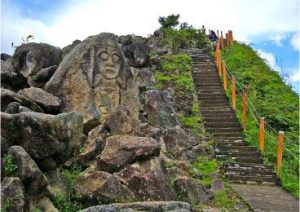
Nevado del Huila
The summit of Nevado del Huila is 5,364 meters above sea level. The snow-capped mountain is one of Colombia’s many paradises and consists of lagoons, streams and rivers.
Parque Arqueológico Tierradentro
Tierradentro is one of the 7 wonders of Colombia. In the catacombs, you can find the remains of a bygone civilization that probably lived in the area 200 years before the birth of Christ.
 San José de Cúcuta, Norte de Santander
San José de Cúcuta, Norte de Santander
The main industries in Norte de Santander are trade and agriculture.
Páramo de Santurbán
This is the main source of water for more than 2 million Colombians. You can find lagoons and Frailejones (plant belonging to the Espletia family).
Pozo Azul
If you are traveling in the department of Norte de Santander, you should definitely visit this lagoon and have your swimming trunks ready. But be careful, the water is cold.
 Armenia, Quindio
Armenia, Quindio
The department of Quindio with its capital Armenia is probably the most touristic area of the coffee zone in Colombia. Therefore, one can find many tourist attractions and breathtaking scenery.
Salento
Salento is certainly one of the most famous tourist destinations in Colombia. The city is also the gateway to the Cocora Valley, where you will find the famous wax palms.
Parque del Café
This amusement park is very well known in Colombia and offers beautiful experiences for the young and old. You will find various attractions related to coffee, but also various amusement rides.
Panaca
Panaca is another amusement park in the region featuring many farm animals.
 Pereira, Risaralda
Pereira, Risaralda
Risaralda and the capital Pereira are neighbors of Quindio and are also located in the Coffee Triangle.
Bioparque Ukumarí
Ukumari is an amusement park with different animals.
Santa Rosa de Cabal
Santa Rosa de Cabal is probably the most famous thermal bath in Colombia. Accordingly, the pool is always well attended.
Apía
I can only recommend a visit to Apia for those traveling to the coffee triangle. The village is not very touristy but offers a fantastic view of the coffee growing region.
 Bucaramanga, Santander
Bucaramanga, Santander
The department of Santander is best known for the range of adventure sports it offers. However, tourists also visit the region for nature and history tours. The Chicamocha Canyon is also found there.
Bucaramanga
This city, better known as the Ciudad Bonita, is a place where there is greenery, many parks, modern architecture and cheerful inhabitants who welcome you as if you were family.
Quebrada las Gachas
The river bed was naturally perforated and today has natural bathtubs. You can also find the most beautiful colors in the river.
San Juan de Girón
San Juan de Giron is only 20 minutes away from the capital and is also in the club of the most beautiful cities in Colombia.
 Ibagué, Tolima
Ibagué, Tolima
The capital Ibagué offers unique music-related experiences and is therefore also known as the “Music Capital of Colombia”.
Cascada La Maravilla
This destination in the Tolima department offers a nature tourism experience. There are several hiking trails and at the end of the hike, you can swim in the first waterfall called La Diosa.
Nevado del Tolima
The volcano is mainly known to mountaineers. You can climb this in tours of 4 or 5 days.

Cañón del Combeima
The Combeima Gorge is a natural paradise and is only 30 minutes from the capital. There you can ride a horse, cable car, do trekking and camp. The views are incredible.
Discover the Magic of the Caribbean Region of Colombia
The Caribbean region of Colombia is a place full of charm, culture and nature. It is located in the north of the country and comprises 8 departments that border the Caribbean Sea. The region also includes the Archipelago of San Andrés, Providencia and Santa Catalina, a tropical paradise with coral reefs, white sand beaches and turquoise waters.
 Barranquilla, Atlántico
Barranquilla, Atlántico
The Atlántico department is home to Barranquilla, one of the most famous cities in Colombia. The destination is best known for its Carnival, where tourists feel welcome thanks to the friendliness and charm of the locals.
Museo del Caribe
The museum is dedicated to the culture of the coast and shows unique exhibits of the region, dance traditions, gastronomic performances and much more.
Castillo de Salgar
This castle has been reconstructed and now shows the history of the Spanish settlers who inhabited the city. Thanks to its location near the sea, you can enjoy the sunset and breezy walks.
Carnaval de Barranquilla
The Barranquilla Carnival is definitely not to be missed, it occurs every year in February. My visit was absolutely great. In addition to the parades, there is a myriad of activities and the whole city is on its feet without a break.
 Cartagena de Indias, Bolívar
Cartagena de Indias, Bolívar
Not only does the Bolivar department offer incredible travel destinations, but also the capital Cartagena, chosen by locals and visitors alike for weddings and special celebrations. Cartagena regularly attracts visitors with its colors and the magic of its streets and islands. More details can be found in my travel guide about Cartagena.
Santa Cruz de Mompox
Mompox is part of Colombia’s cultural heritage and has history and culture. The village is also a special place for religious tourism, due to the number of basilicas with interesting architecture.
San Basilio de Palenque
Considered the first free town in America, San Basilio de Palenque was founded by Africans who fled slavery. San Basilio is characteristic for its gastronomy and for the beautiful African women with their dances and customs.
San Jacinto
San Jacinto is known for making hammocks, but you can also find a wide variety of handicrafts that represent Colombian culture and its indigenous background.
 Valledupar, Cesar
Valledupar, Cesar
The Cesar department is home to the “Creative City of Music”, better known as Valledupar. The capital of the Valledupar department is a magical city that offers the best of Colombia’s representative musical genre and is one of the country’s top Easter destinations.
Balneario La Mina
About 25 miles (40 km) from Valledupar you can find the Badillo River. This flows between huge rocks that can also be crossed on foot. It’s a great place to swim and spend a day with the family.
Ecoparque Los Besotes
Los Besotes offers a variety of hiking trails, some with lookouts, forests, and observatories. There are also waterfalls and streams that you can enjoy. Allow yourself the opportunity to be in nature and switch off from everyday life.
 Montería, Córdoba
Montería, Córdoba
Cordoba is a department full of culture and tradition that, in addition to its history, is also known for ecotourism. The department offers beaches, rivers and parks with beautiful landscapes.
Parque Nacional Natural Paramillo
This park is ideal for getting in touch with nature and enjoying the biodiversity of the Caribbean. In the park you can walk in different ways, enjoy the waterfalls and lagoons and get to know a variety of animal species.
Montería
The capital of the department of Cordoba can be explored on foot, by car or by bike. There are also a variety of cathedrals, restaurants and history centers.
Lorica
Santa Cruz de Lorica was founded in 1740 and still has magnificent architecture today. It is not without reason that Lorica is a member of the exclusive club of the 17 most beautiful historic cities in Colombia. Lorica is now also a trading town and is definitely worth a visit.
 La Guajira
La Guajira
The department of La Guajira stretches along the Caribbean coast and borders Venezuela to the east. The northern part is a desert area and is inhabited by the Wayuu. There is huge tourist potential and the journey through the desert to the northernmost point of the continent is a real adventure.
Palomino
Palomino is the most famous destination in La Guajira and was first known as a hippie destination. Today, however, you can find various offers and national and international tourism is drawn to the region. Although not suitable for swimming, the beaches are very beautiful. In addition, the rivers invite you to tubing.
Cabo de la Vela
Cabo de la Vela is a simple fishing village in the Guajira desert. However, the constant wind and shallow water make it a paradise for kite surfers. Electricity and water are rationed and life is simple, so the perfect place for some real deep relaxation.
Punta Gallinas
The northernmost point of the continent offers a unique experience. The destination can be reached by boat or 4×4 vehicles. One finds a desert landscape and dunes that end directly in the sea. For me one of the most magical places in Colombia.
 Santa Marta, Magdalena
Santa Marta, Magdalena
This department with its capital Santa Marta attracts millions of tourists every year. In the vicinity of Santa Marta you can find some of the most beautiful beaches in Colombia and among Colombians, the city, like Cartagena, is known for weddings and important celebrations.
Parque Sierra Nevada de Santa Marta
The Sierra Nevada de Santa Marta has an eventful history behind it. It was and is not only a refuge for various indigenous tribes, but is also the highest coastal mountain range in the world. I can only warmly recommend a visit.
Parque Nacional Natural Tayrona
I probably don’t have to tell much about the Tayrona National Park, it is known far beyond the borders of Colombia. Definitely put on the list of places to visit!
El Rodadero
El Rodadero is a true Colombian experience. The long beach fills up with families and visitors, especially on weekends and holidays. Loud music, beach vendors and everything that makes the Colombian heart beat faster can be found here in a very small space.
 San Andrés y Providencia, San Andrés
San Andrés y Providencia, San Andrés
San Andres & Providencia are located in the middle of the Caribbean and far away from the Colombian mainland. They are classic bathing destinations.
Casa Museo Isleña
This museum shows the traditions and customs of the Caribbean. Here you can learn more about the life of the islanders, their way of doing everyday things and cooking.
Cabeza de Morgan
This rock, which resembles a human’s head, is known for its unique formation.
Johnny Cay
Johnny Cay is a small barrier island off of San Andres. You should definitely visit them.
 Sincelejo, Sucre
Sincelejo, Sucre
This destination is best known for its beautiful beaches. In Sincelejo, the capital, you can visit different mountains, swamps and savannas. This beautiful city enchants its visitors with a mixture of music from Europe, Africa and America.
San Francisco de Asís
The spectacular cathedral is frequented by Colombians and foreigners due to its construction.
Coveñas
A typical seaside resort in the department. It has a natural pool.
Tolú
Also a seaside resort. There you will also find a connection to the offshore islands.
Experience the Biodiversity of the Amazon Region of Colombia
The Amazon region of Colombia is one of the six natural regions of the country. It covers about 42% of the national territory and is part of the Amazon rainforest, the largest and most diverse tropical forest in the world. The region is crossed by the Amazon River, the longest and most voluminous river on Earth, and its tributaries, such as the Caquetá, Putumayo, Guaviare, Apaporis and Vaupés rivers. The region is home to a rich variety of flora and fauna, including endemic species such as the pink river dolphin, the Victoria amazonica (a giant water lily), the manatee, the jaguar, the giant otter and many others. The region also hosts different indigenous communities that preserve their ancestral cultures and traditions. The Amazon region of Colombia offers a unique opportunity to explore and enjoy the wonders of nature, as well as to learn about the history and culture of its inhabitants.
 Amazonas
Amazonas
This area has the same name as the river, which also flows through there. The department offers nature and beautiful landscapes. I always say, “Anyone who has the opportunity to visit the Amazon once in a lifetime should not miss it.”
The region is also known as the “lungs of the world” since the entire Amazon area covers around 6 million square kilometers of trees that absorb millions of tons of carbon dioxide from the atmosphere. Also, the Amazon region also makes up around a third of the entire Colombian territory. If you are looking for the top stunning nature tourist destination, this is it!
Parque Nacional Amacayacú
This park, located in the Amazon trapezoid, is part of the Colombian national parks. A variety of activities can be enjoyed in Amacayacu, including bird watching and walks surrounded by natural areas with tropical animals.
Parque Nacional Natural Serranía del Chiribiquete
This park is home to the largest tropical rainforest in North and South America. It is not open to the public and tourists can only fly over it. Unfortunately, clearing due to expanding cattle breeding is increasingly affecting the park. Thanks to its amazing nature, tourists still refer to it as the “greatest wonder of Colombia”.
The park is also known as La Maloca del Jaguar. This is due to the cave paintings that allude to the cult of the jaguar, which stands for fertility and power, but also for the dance, warrior and hunting of indigenous culture, which is why several tribes that do not inhabit the place consider it a sacred area.
Puerto Nariño
This city, which belongs to the Amazon department, impresses with its incredible landscapes. It is about two to three hours by boat from Leticia, the capital of the department. I definitely recommend a visit. You can spend the night there, and the place also combines the cultures and cuisines of Colombia, Peru and Brazil.
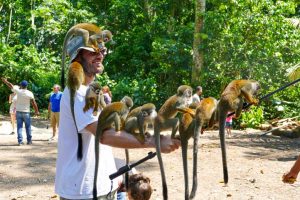
 Florencia, Caquetá
Florencia, Caquetá
The department is an indispensable destination for visiting the landscapes of the Amazon region and enjoying the country’s (partly still untouched) nature.
I visited Florencia some time ago. Tourism is not yet strongly developed, because in Colombia the zone is known as a guerrilla stronghold. Although the fighters have long withdrawn from the area, Colombians are very reluctant to travel to the area. However, I expect a large increase in visitor numbers in the following years, because the tourist potential for nature tourism is gigantic.
Florencia
The capital of the department has a lot to offer in terms of tourism. You can find monuments, museums, parks, cultural centers and much more. While walking through Florencia, you should definitely stop by the main square and buy an ice cream.
Museo Caquetá Orgullo de Colombia
The museum houses more than 200 exhibits that recall the history of Caquetá. It displays photographs and a collection of works that reflect the culture and heritage of the place.
Reserva Natural Las Dalias-Cañón del Niño
In the Cañón del Niño there is a rock formation from which minerals are released. You can also swim in the nearby waterfall.
 Inírida, Guainía
Inírida, Guainía
Guainía offers adventure and nature in one place. Within the department is the largest river and nature reserve in the world, the Estrella Fluvial del Oriente Reserve.
The capital Inírida was founded by the indigenous ancestors, its name comes from the Puinave language and means “small mirror of the sun”. The town is small but cozy and well worth a visit.
Cerros de Mavecure
This mountain group consists of three different hills, Mono, Pajarito and Mavicure. The hills can only be visited by the river route. The panorama is spectacular and will certainly attract a stream of visitors in the future.
La laguna de la Bruja
Of course there are no witches in the lagoon of the witch, but you will find incredible silence and pink dolphins!
Sendero Ecoturístico Flor de la Inírida
On this ecotourism trail, you can enjoy the Inírida flower, which impresses with its bright red color and characteristic formation. The flower only grows on sandy soils near the Inírida and Guainía rivers.
 San José del Guaviare, Guaviare
San José del Guaviare, Guaviare
This wonderful department has not yet seen a tourist boom. However, the department is located in the transition from Los Llanos to the Amazon region and offers incredible nature experiences. There are also various national parks in the Guaviare.
Cerro Azul
Cerro Azul, also known as Cerro Pinturas, has a little known history. When visiting the hill one has the opportunity to see some well-preserved cave paintings in red color made by the ancestors (Carijonas Indians). The paintings show the life, myths and rituals of the tribe.
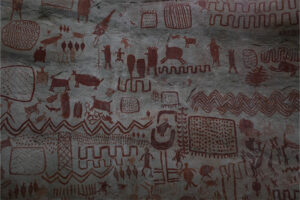
Caño Sabana
The river glows in different colors at certain times of the year. This phenomenon is caused by various plants.
Laguna Negra
This incredible paradise was named after the leaves that settle deep in the lagoon, giving the water a black coat and contrasting with the sunsets.
 Mocoa, Putumayo
Mocoa, Putumayo
Putumayo was also occupied by armed groups for a long time. However, this led to the conservation of the region and today you can find unspoiled nature in the department.
Cascadas Fin del Mundo
The Fin del Mundo is certainly one of the most spectacular waterfalls in Colombia. I can definitely recommend a visit.
Mocoa
Mocoa is the capital of Putumayo. From here there are different offers for an ayahuasca experience with local indigenous tribes.
Donde se oculta el sol
Here you should visit the Mohana waterfall.
 Mitú, Vaupés
Mitú, Vaupés
Inhabited by some of Colombia’s 25 indigenous peoples, this department offers a stay full of nature, biodiversity and adventure. Although the capital, Mitu, is just a small and simple town, it offers a variety of bird watching, nature and culture opportunities. It is also inhabited by several indigenous tribes and is the country’s cultural and historical source.
Parque Yaigojé Apaporis
A park with biodiversity in the region and a warm climate typical of the Amazon region.
Raudales de Yurupary
If you are interested in history and want to learn something about the native tribes, I recommend a visit to the Raudal. Here you can see figures carved in stone with symbols of the indigenous tribes, visit the mazes and explore the biodiversity of the place.
Serranía Morroco
A plan that includes an extensive hike to the top of the mountain range, from where you can see the landscape and the jungle from above.
Enjoy the Beauty and Culture of the Llanos Region of Colombia
The Llanos region of Colombia is one of the six natural regions of the country. It is located in the east of the country and covers about 28% of the national territory. The region is characterized by its flat and vast plains, crossed by rivers such as the Orinoco, the Meta, the Arauca and the Guaviare. It has a warm and dry climate, with two marked seasons: rainy and dry. This part of the country is known for its rich natural and cultural heritage, including diverse ecosystems, wildlife, folklore, music and gastronomy. The region is also home to different indigenous groups, such as the Guahibo, the Sikuani, the Puinave and the Curripaco. The Llanos region of Colombia offers a variety of attractions for all kinds of travelers. You can admire the stunning sunsets, visit the natural parks and reserves, enjoy the traditional festivals and joropo music, taste the delicious dishes and drinks, or explore the historical and cultural sites.
 Arauca, Arauca
Arauca, Arauca
Thanks to its location in the plains, the department has widespread cattle breeding. If you want to try a good, typical Colombian dish, you should definitely try the “Llanera” meat and its side dishes (potatoes, yucca, plantains). Cocoa is also produced in Arauca, which is considered to be one of the best in the world because of its “fine aroma”.
Puente Internacional José Antonio Páez
This bridge is of great importance as it connects Colombia and neighboring Venezuela. It is currently the main route for oil trade and economic progress in the department.
Malecón
After crossing the José Antonio Páez Bridge, one can hike along the path along the border with Arauca and see the islets where some of the indigenous tribes lived. I recommend hiring a private guide who can explain in detail about the life of the indigenous groups in the department and what they mean to the country.
Fórum Los Libertadores
This place is ideal for events and celebrations. If you like to visit places with a lot of people, then this place is ideal. On the website you can find out about the events during the year. Also, there you will find the monument to Joropo, a typical local dance.
Mangas de Coleo
Coleo is considered a sport and is famous in the department. The sport consists in a person chasing bulls on a horse, with the main aim of bringing the bull down by pulling it on its side by the tail and thereby throwing it off balance.
 Yopal, Casanare
Yopal, Casanare
The Llanos de Casanare are my second home in Colombia. I have visited this region many times and would recommend a trip there to everyone. The capital Yopal offers varied nature and warm weather in the area. The department is best known for its cattle breeding. The local cowboys, who traditionally walk without shoes, are also perfect guides for a safari.
Reserva Natural El Encanto de Guanapalo
El Encanto offers a safari experience where you can see different species of birds and animals. Of course, an insight into cattle breeding is also included. This plan is recommended for photographers and tourists who want to find themselves surrounded by incredible landscapes and exotic wildlife.
Reserva Natural La Aurora
La Aurora is a pioneer in tourism and is known for preserving the local species. A focus is attached to the protection of the jaguar. You will find detailed descriptions of the different animals in the accommodation as well as photos taken with self-releasing cameras. A few years ago I flew there on a small plane from Yopal. Just the flight was a huge experience.
On site you can go on safaris and learn about the need for conservation in the Llanos. At the right time of year, you can also try your luck and look for anacondas in the mud.
San Miguel de Farallones
This nature reserve offers fantastic views and one of the best climates in the department of Casanare. Activities such as horse riding, hiking, gastronomic tastings and much more can be enjoyed.
I recommend interested travelers to consult my Casanare travel guide.
 Villavicencio, Meta
Villavicencio, Meta
The capital Villavicencio can be reached quickly and easily from Bogota by car. A little outside of Villavicencio you will find various tourist attractions. The department also belongs to Los Llanos, the vast eastern plains, which are partially flooded during the rainy season. Cattle breeding and llanos safaris can therefore be found in many places.
Caño Cristales
One of the most famous rivers in Colombia is the Cano Cristales. During various months of the year, plants let the river shine in 7 colors. The hike is long and strenuous
Bioparque Los Ocarros
This park is home to a wide variety of animals, most of which are critically endangered or known only to a few people, such as the giant armadillo.
Cañón del Güejar
The river is ideal for a rafting experience.
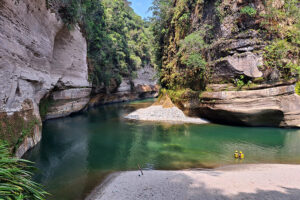
 Puerto Carreño, Vichada
Puerto Carreño, Vichada
The department of Vichada is also part of Los Llanos. Its capital is Puerto Carreño, a welcoming community with a warm climate.
Puerto Carreño
The capital of the department offers various services and tourist destinations. Puerto Carreño is best known as an angler’s paradise.
Parque El Tuparro
This beautiful park is characterized by its rock formations. The river landscape and the great biodiversity are definitely worth a visit. Due to the climate, I recommend a tour in December or January.
Raudal de Maipures
This rocky structure is located in El Tuparro Park. Inside the place, you have the opportunity to camp and enjoy a beautiful sunset.
Discover the Diversity of the Pacific Region of Colombia
The Pacific region of Colombia is one of the six natural regions of the country. It is located on the western coast of the country, bordering the Pacific Ocean. It covers an area of 83,170 km² (32,110 sq mi) and includes part or all of the departments of Chocó, Valle del Cauca, Cauca and Nariño. The region is characterized by its high rainfall, biodiversity and cultural diversity; hosts one of the rainforests with the largest number of species per square kilometer in the world, and the Atrato River, one of the most voluminous of the planet. The region is also home to different marine and terrestrial ecosystems, such as mangroves, coral reefs, beaches, islands and mountains. It also has three natural parks that are declared World Heritage Sites by UNESCO: Gorgona, Utría and Malpelo. The region is also known for its rich Afro-Colombian culture, expressed in its music, dance, cuisine and traditions; also has different indigenous groups, such as the Embera, the Wounaan and the Awá. The Pacific region of Colombia offers a unique opportunity to discover and enjoy the diversity of nature and culture.
 Popayán, Cauca
Popayán, Cauca
The department is mainly characterized by its majestic forest reserves. The capital of Cauca, Popayán, is known as the “White City”. Its architecture reflects the good management and preservation that its residents have given to them. Most of the buildings are painted white. Popayan is considered to be one of the oldest cities in Colombia, which is also reflected in its religious traditions and architecture.
Cauca is still a complicated department and security is not guaranteed in all regions. Although Popayan is absolutely harmless, one should not travel to the regions outside of the capital carelessly. Popayan is also a student city. Unfortunately, numerous facades are smeared again and again during demonstrations by young intellectuals, which affects the beauty of the city.
Parque Nacional Puracé
This volcanic chain with several sulfur springs offers some tourist attractions. You can find beautiful lagoons, forests and moors. In addition to the different landscapes, you can also find different species of birds such as the incredible Andean condor. Purace is indigenous territory.
Isla Gorgona
This island was previously used as a prison and was great torture for Colombian prisoners. Today the island is a natural park where one can enjoy adventurous activities like sport fishing, snorkeling, diving and much more.
 Quibdó, Chocó
Quibdó, Chocó
This biodiverse department is one of the rainiest in the country but is ideal for visits to unspoiled nature. The capital Quibdó is one of the most important timber and mining centers in the country. Unfortunately, there are also countless illegal mines in this area and the pollution from them is enormous. It is to be hoped that the situation will improve in the future.
Sapzurro
This small town with no more than 500 inhabitants is on the border with Panama. Within the city is the bay of Sapzurro. So far, this destination has only been known to backpackers, but that can change quickly.
Nuquí
Nuqui has already established itself as a tourist destination and offers a variety of different accommodations. You can find hotels and eco-lodges in and around Nuqui. It is the perfect destination to enjoy the beauty of the Pacific and whale watching between June and November. Nuqui is also known as a good place to surf. What I can say from my own experience, the food there is absolutely great. Fresh from the sea on your plate.
Bahía Solano
Bahia Solano is the best alternative to Nuqui. It is less touristy and also offers many tourist activities and sensational beaches.
 Pasto, Nariño
Pasto, Nariño
The department of Nariño is best known for its capital, Pasto. La Ciudad Sorpresa, as this beautiful city is called, stands out every year for its Carnaval de Negros y Blancos (black and white carnival) and its well-preserved architecture. The department also has a large number of volcanoes and natural paradises.
Parque Cañon de Juanambú
This place is known as the site of the Battle of Juanambú, in which General Antonio Nariño fought against the Spanish army. Here you can not only learn about the history of the place, but also go camping and engage in various activities such as climbing, bungee jumping, hiking, kayaking and much more.
Reserva El Búho
The El Buho reserve in Narino is certainly one of the most beautiful natural paradises in the region.
Santuario de Fauna y Flora del Volcán Galeras
The Las Galeras volcano is 4,276 meters above sea level. Although you may not be able to climb the volcano, the surrounding area offers a variety of spectacular nature experiences.
 Cali, Valle del Cauca
Cali, Valle del Cauca
The capital, Cali, is known for being a city of rhythm, dance and culture. Cali is known as the capital of salsa for a reason.
San Cipriano
San Cipriano is a natural paradise and is known for bathing in the river. The journey takes place on so-called “Brujas”.
Parque Nacional Natural Bahía Málaga
Bahia Malaga is known for whale watching between July and November.
Buga
Every year, many locals visit the main church to be consecrated and to ask the Virgin for her blessings.
Parque de Aventuras Piedemonte
The park offers adventure for family or friends.
Colombia Travel Tips
- Colombia Travel Medical Advice & Vaccination Details
- 29 Travel Tips You Need To Know Before Coming To Colombia
- 99 Facts & Information About Colombia You Should Know
- Colombia Weather Guide for Travelers
More Destinations in Colombia
- 99 Must-See Destinations that Will Make You Fall in Love with Colombia
- Colombia’s Top 23 Largest and most Important Cities – Key Data and Insights
- 7 Wonders of Colombia Complete Guide
- Colombia’s Top 117 Museums: A Cultural Traveler’s Comprehensive Journey
- 21 Spectacular Churches in Colombia
- What Are The Best Luxury Destinations In Colombia?
- Sample Luxury Travel Itinerary in Colombia
- Instagram Colombia – The 17 Most Beautiful Places for Photos
Beaches in Colombia
- Colombiafrank’s True Beach Guide – Colombia’s Most Stunning Beaches
- 19 Colombian Paradise Islands You Should Visit Soon
- Rosario Islands & Baru: Don’t Get Scammed and use this Guide
- Cartagena’s Crowded Shores: Unmasking the Reality with Idyllic Alternatives
Bogotá Experiences
- The 9 Most Spectacular Markets In Bogota That You Must Visit
- 15 TOP Must See Attractions in La Candelaria, Bogota Colombia
- Bogota’s 13 Most Beautiful Parks
- Craft Beer Tour in Bogotá – Explore 15 Must-Visit Breweries
Top Activities
- Top 99 Best Activities and Attractions in Bogota
- Top 46 Best Activities and Attractions outside Bogota
- Top 67 Best Activities and Attractions in Medellín
- Top 43 Activities and Attractions outside Medellin
- Top 39 Activities and Attractions in Cartagena
- Top 36 Activities and Attractions outside Cartagena
- Top 23 Activities and Attractions in Santa Marta
- Top 36 Activities and Attractions outside Santa Marta
Other destinations and experiences in Colombia
- 9 Offers for Spiritual Retreats and Yoga in Colombia
- Top 15 Best Romantic Destinations in Colombia for Couples and Honeymoons
- The 11 Best Destinations for Getting Married in Colombia
- The 9 Best and Most Fun Theme Parks in Colombia
- 7 Amazing Tourism Experiences Offered by Former FARC Fighters in Colombia
- Pablo Escobar-related tourism, blessing or curse for Colombia?
- The 9 UNESCO World Heritage Sites in Colombia
- 32 Places to Discover Colombia’s Colonial Architecture
- Wine Tours and Tastings in Colombia – Explore 9 Must-Visit Vineyards
- Colombia’s 22 Most Luxurious Restaurants: Discover Them All
- Where to Find Vegetarian and Vegan Food in Colombia’s Main Cities
- Santuario Las Lajas – The Most Spectacular Basilica in Colombia
- The most important information about Filandia Quindio, Colombia
Dear Reader
Liked our content? You are welcome to share it and spread the message that Colombia is one of the most beautiful countries in the world.

